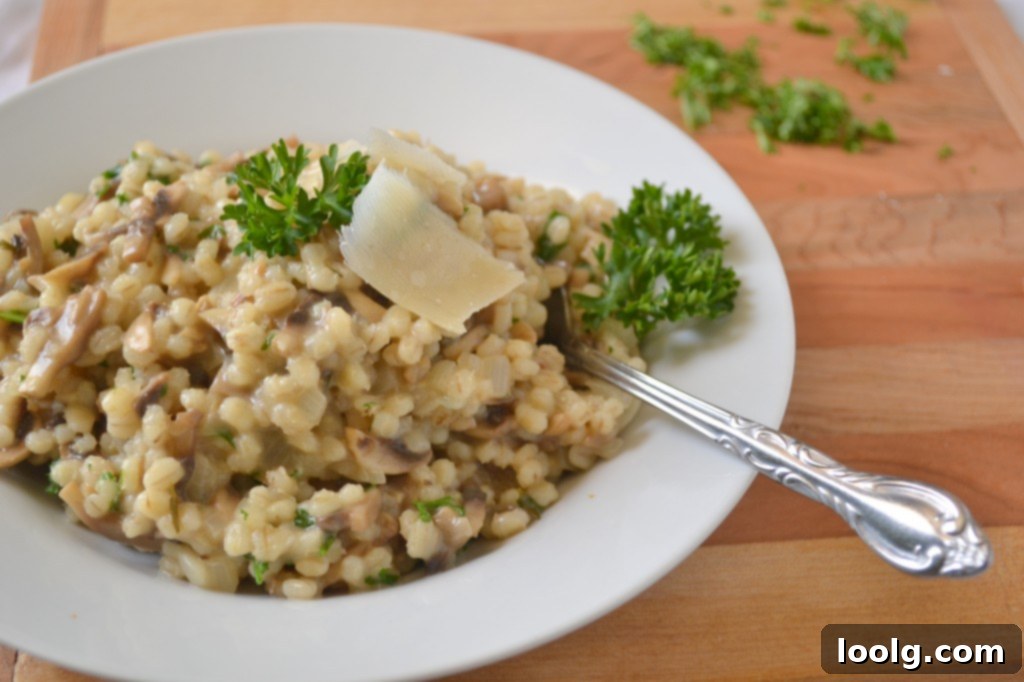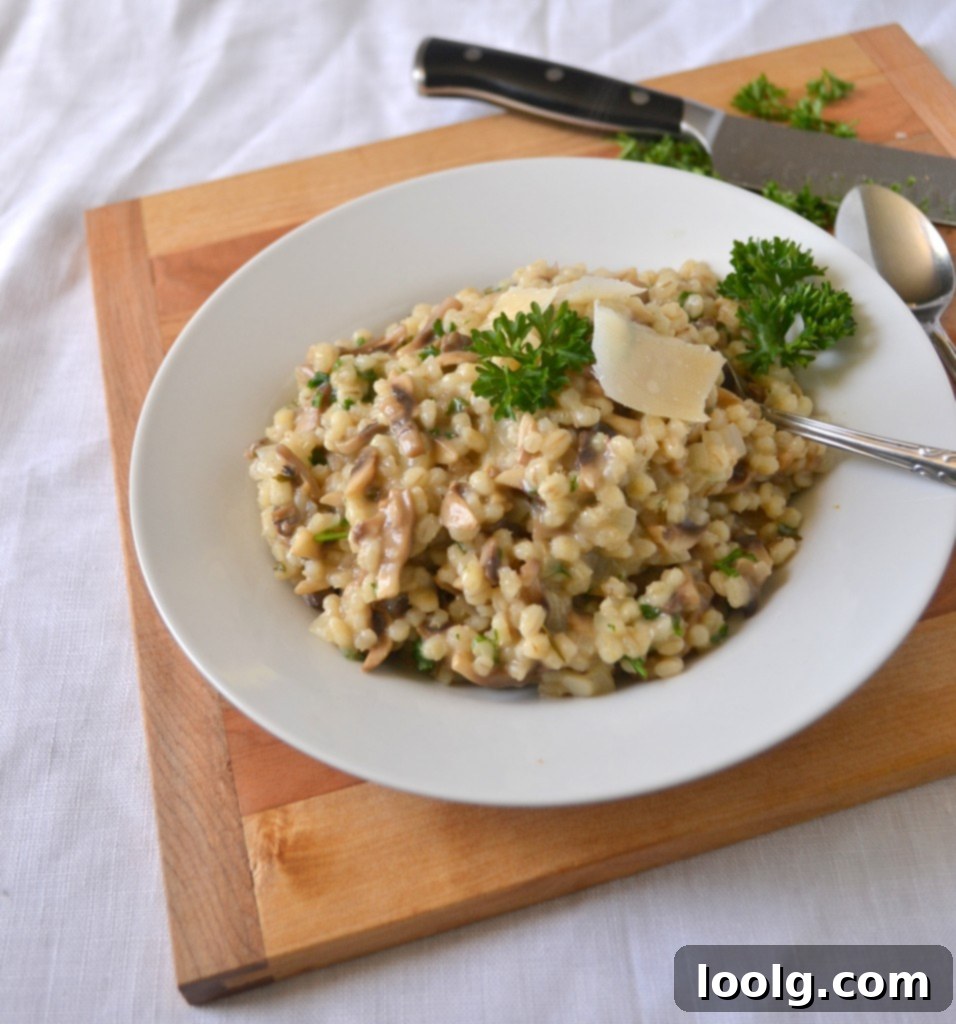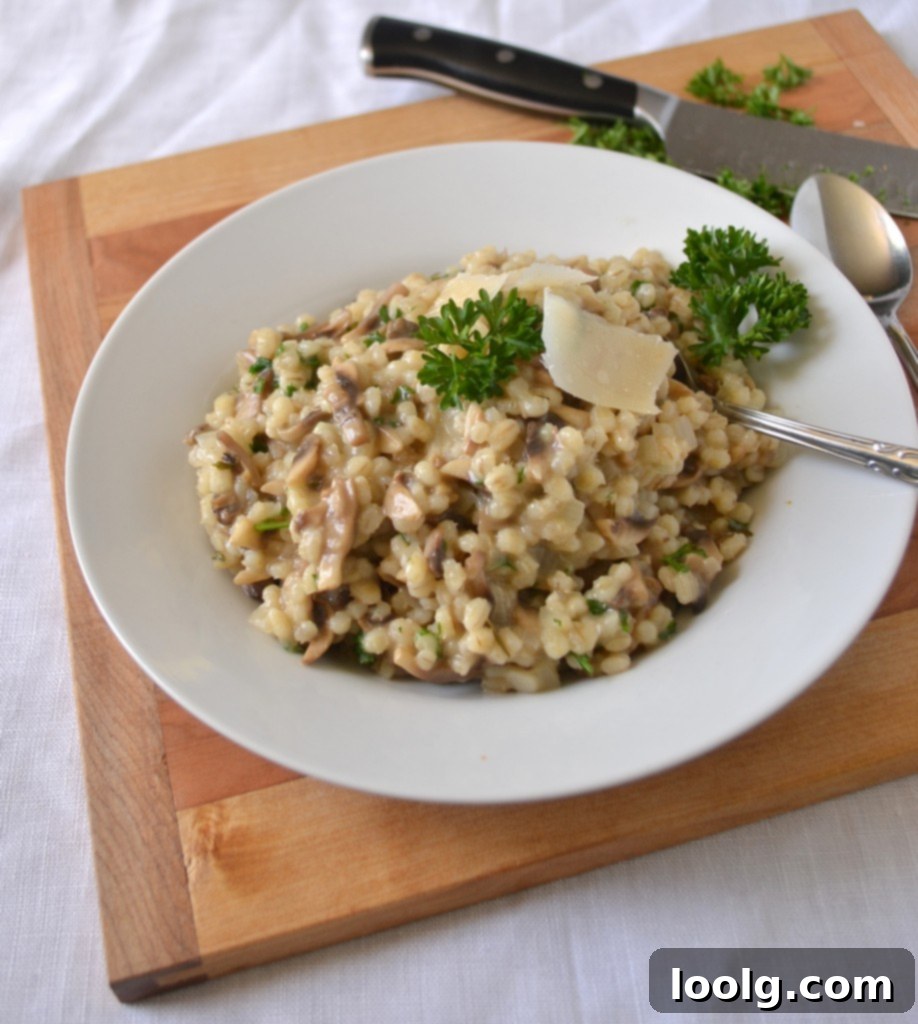Creamy & Wholesome: Mushroom Barley Risotto – A Healthy Whole-Grain Twist

Risotto holds a special place in the hearts of many food enthusiasts, and mine is no exception. That rich, creamy texture and comforting warmth make it an irresistible dish. However, traditional risotto often relies on white Arborio rice, which, while excellent for achieving that signature creaminess, lacks the nutritional punch of its whole-grain counterparts. White rice has been stripped of its bran and germ – the very parts that contain over half of the grain’s vital nutrients, including fiber, B vitamins, and essential minerals.
This nutritional compromise has always been a point of contention for me. While brown rice is a healthier option, it simply doesn’t yield the same luscious, thick consistency that makes risotto so beloved. Its bran prevents the release of starches necessary for that characteristic creaminess, often resulting in a chewier, less cohesive dish. For years, I searched for a whole-grain alternative that could deliver on both flavor and nutrition without sacrificing texture.

Discovering Barley: The Perfect Whole-Grain Risotto Solution
My culinary journey led me to a game-changing discovery: using barley in place of rice for risotto. The moment I learned that barley could achieve a similarly creamy and satisfying dish, I knew I had to try it. And I am incredibly glad I did! Barley not only delivers on texture but also significantly boosts the nutritional value of this classic comfort food. It truly offers the best of both worlds – a delightfully creamy risotto that’s also packed with health benefits.
Why Choose Barley Over Rice for Risotto?
Barley stands out as an exceptional choice for risotto for several compelling reasons, primarily its robust nutritional profile and its unique starch composition. Nutritionally, barley is a powerhouse. It is significantly higher in fiber than brown rice, particularly soluble fiber, which is known for its ability to help lower cholesterol and regulate blood sugar levels. A single serving of barley can provide a substantial portion of your daily fiber needs, promoting digestive health and helping you feel fuller for longer.
Beyond fiber, barley is also a fantastic source of various essential nutrients. It contains a higher amount of selenium compared to many plant-based sources, an important trace mineral that acts as an antioxidant and plays a role in thyroid function and immune health. Additionally, barley provides magnesium, phosphorus, manganese, and B vitamins, all crucial for overall well-being. By opting for barley, you transform a traditionally indulgent dish into a truly wholesome meal without compromising on taste or satisfaction.

Understanding Barley Types: Pot Barley vs. Pearled Barley
When selecting barley for your risotto, the type you choose makes a difference in both nutrition and cooking time. For this recipe and for maximizing health benefits, I strongly recommend seeking out **pot barley** or **scotch barley**. These terms refer to hulled barley that has had only the outermost inedible hull removed, leaving the nutritious bran and germ largely intact. This minimal processing ensures you get the full spectrum of barley’s fiber, vitamins, and minerals. Pot barley will take longer to cook than pearled barley, but the rich, earthy flavor and superior nutritional content are well worth the extra time.
On the other hand, **pearled barley** has had its bran layer removed and has been polished. While it cooks much faster due to the absence of the bran, it is nutritionally very similar to white rice once processed. A significant portion of its fiber and nutrients is lost during the pearling process. Therefore, to truly benefit from the “whole grain” aspect of this dish, it’s worth the effort to find unprocessed pot or scotch barley with the bran still intact. This ensures that the majority of the nutrition, particularly the vital fiber, remains in your dish.
If you’re looking for a delightful vegan version of this comforting dish, be sure to try this Creamy Vegan Mushroom Risotto! It offers a fantastic plant-based alternative that doesn’t skimp on flavor or texture.
Mushroom Barley Risotto: The Recipe
This recipe combines the earthy goodness of mushrooms with the wholesome texture of barley, creating a risotto that’s both comforting and incredibly satisfying. The slow cooking process allows the barley to release its starches, resulting in a naturally creamy and thick consistency that rivals traditional rice risottos.
Ingredients:
- 3-4 tbsp unsalted butter, divided
- 1 large yellow onion, finely diced
- 3 cloves garlic, minced
- 1/2-3/4 lb (about 225-340g) fresh mushrooms (cremini, shiitake, or a mix work beautifully), sliced or quartered
- 1 C pot or scotch barley
- 3 1/2-4 C hot water or vegetable stock (low sodium preferred)
- 1/4 C fresh parsley, chopped
- 2 tsp fresh thyme, chopped
- 1/2 C freshly grated Parmesan cheese (omit for vegan, use nutritional yeast or vegan Parmesan alternative)
- 1/2 tsp sea salt or more to taste
- Freshly ground black pepper to taste
Instructions:
- Prepare Your Stock: In a small pot, heat your vegetable stock or water until it comes to a boil. Once boiling, reduce the heat to low to keep it hot, or simply turn off the heat and set aside. Keeping the liquid hot is crucial for maintaining the risotto’s temperature and ensuring even cooking.
- Sauté Aromatics: In a large, heavy-bottomed pan or Dutch oven, melt half of the butter (about 2 tablespoons) over medium heat. Once the butter is shimmering, add the finely diced onion and cook, stirring occasionally, until it becomes soft and translucent, about 5-7 minutes.
- Add Garlic and Barley: Stir in the minced garlic and cook for another 1-2 minutes until fragrant, being careful not to burn it. Add the pot barley to the pan along with the fresh thyme. Stir everything together and let the barley toast lightly for about 2-3 minutes. This toasting step helps to bring out a deeper, nuttier flavor in the barley.
- Begin the Risotto Process: Pour in 1 cup of the hot stock or water. Stir continuously, bringing the mixture to a gentle boil. Adjust the heat as needed to maintain a steady simmer. The barley will begin to absorb the liquid.
- Gradual Liquid Addition: Once the liquid has been almost completely absorbed by the barley, add another half cup of hot stock. Continue to stir frequently. Repeat this process – adding a half cup of liquid at a time, stirring until it’s absorbed – until all the water or stock is gone, or until the barley is tender yet still has a slight chew (al dente) and the mixture is creamy. This step typically takes about 45-50 minutes. The frequent stirring is essential as it helps to release the starches from the barley, creating that signature creamy texture.
- Cook the Mushrooms: While the barley is cooking, prepare your mushrooms. In a separate small pan, melt the remaining butter (1-2 tablespoons) over medium heat. Once hot, add the sliced mushrooms along with a sprinkle of salt and pepper. Sauté the mushrooms until they are soft and have released their liquid, about 5-8 minutes. Set aside.
- Finish the Risotto: Once the barley is tender and creamy, remove the pan from the heat. Stir in the cooked mushrooms (including any delicious liquid accumulated in the mushroom pan), the chopped fresh parsley, and the freshly grated Parmesan cheese. Stir vigorously for a minute or two; this process, known as “mantecare,” helps to emulsify the butter and cheese, making the risotto incredibly smooth and creamy.
- Season and Serve: Taste the risotto and season with additional salt and freshly ground black pepper as needed. Serve hot, garnished with extra Parmesan cheese and a sprinkle of fresh parsley for an inviting presentation and added flavor.
Tips for a Perfect Barley Risotto
- Use Hot Stock: Always keep your stock or water hot. Adding cold liquid can shock the barley, slowing down the cooking process and potentially affecting the final texture.
- Stir Consistently, But Not Constantly: Frequent stirring is key to releasing the starches for creaminess, but you don’t need to stir every single second. Stir often enough to prevent sticking and encourage starch release.
- Taste and Adjust: The amount of liquid needed can vary slightly depending on your barley and pan. Taste the barley periodically to check for tenderness. The risotto should be creamy but not soupy, and the barley should have a pleasant chew.
- Fresh Ingredients: Fresh herbs like parsley and thyme make a significant difference in the flavor profile. Don’t skimp on quality ingredients.
- Cheese Matters: Use good quality, freshly grated Parmesan cheese for the best flavor and melting consistency.
- Don’t Rush It: Risotto is a dish that rewards patience. Allow the barley to slowly absorb the liquid and release its starches.
This Mushroom Barley Risotto is not just a meal; it’s an experience. It offers a comforting, hearty dish that satisfies the soul while nourishing the body. It’s a testament to how simple ingredient swaps can transform a classic into an even more wholesome delight.
Have a great weekend and enjoy this incredible dish!